Learn how to make focaccia bread with this easy and simple recipe that’s an absolute crowd-pleaser!
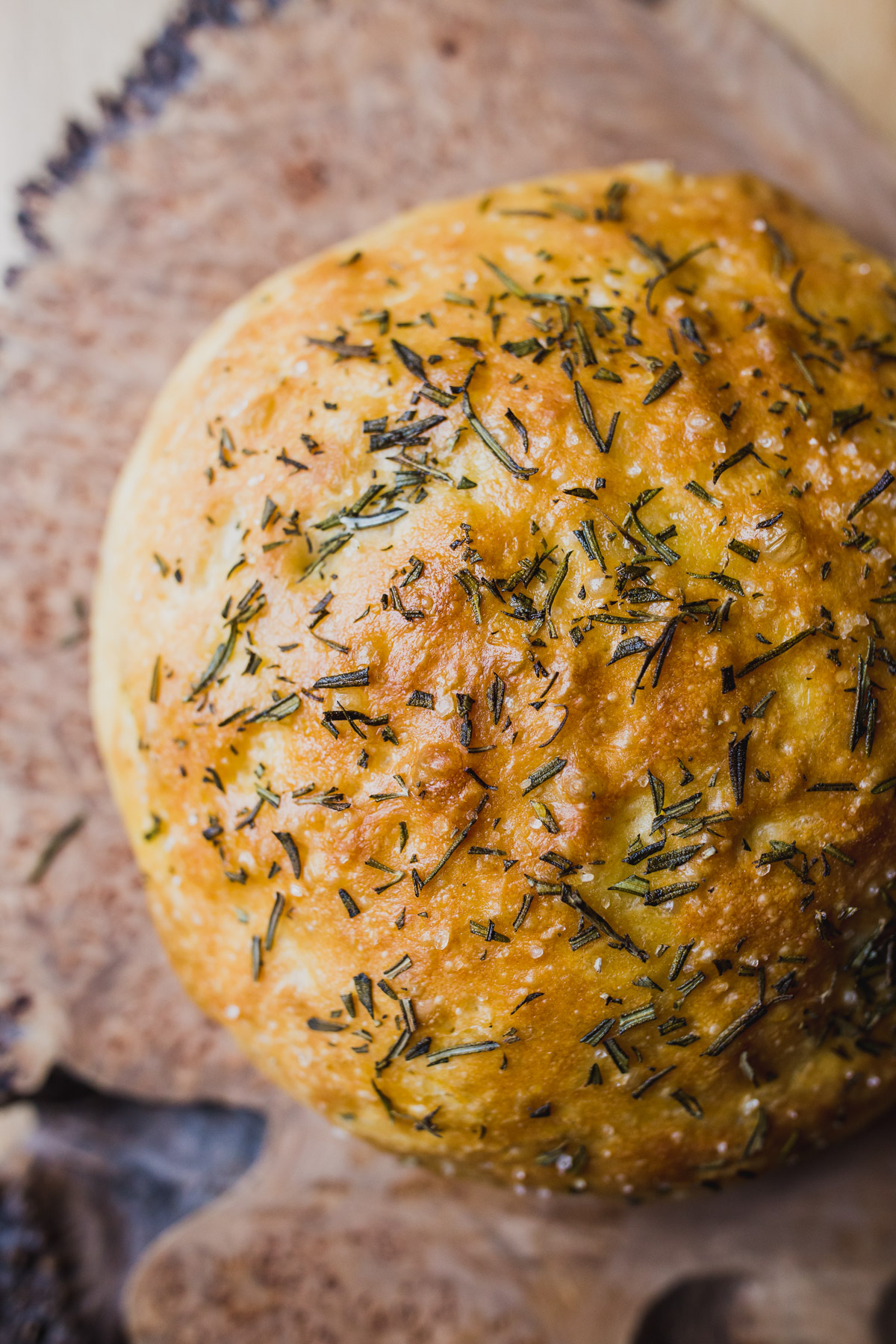
Over the holidays we spent a lot of time baking, and not just cookies and my go-to sourdough. I finally tried my hand at making homemade focaccia and the results were pretty astounding! It ended up being very simple and absolutely delicious. Plus, my kids, even the one who claims to not like bread, devoured it!
That signature fluffy, airy interior, crisp exterior and soft, chewy texture throughout is easy to accomplish and makes you look like a real professional in the kitchen. This good focaccia bread recipe is perfect for Italian meals, a yummy bread for sandwiches or paninis, or a great side to bring to your next dinner party.
All you need is some basic ingredients, plenty of extra virgin olive oil, a little bit of patience and you’ll have a stunning round loaf of focaccia that will have everyone begging you for the recipe.
The History & Origins of Focaccia Bread
So, where exactly does focaccia come from? If you’ve ever visited Italy, you might have guessed that this is the birthplace of this beloved Italian flatbread. You’ll see it in shops and bakeries all over Italy. It has a rich and ancient history that dates all the way back to the Roman Empire.
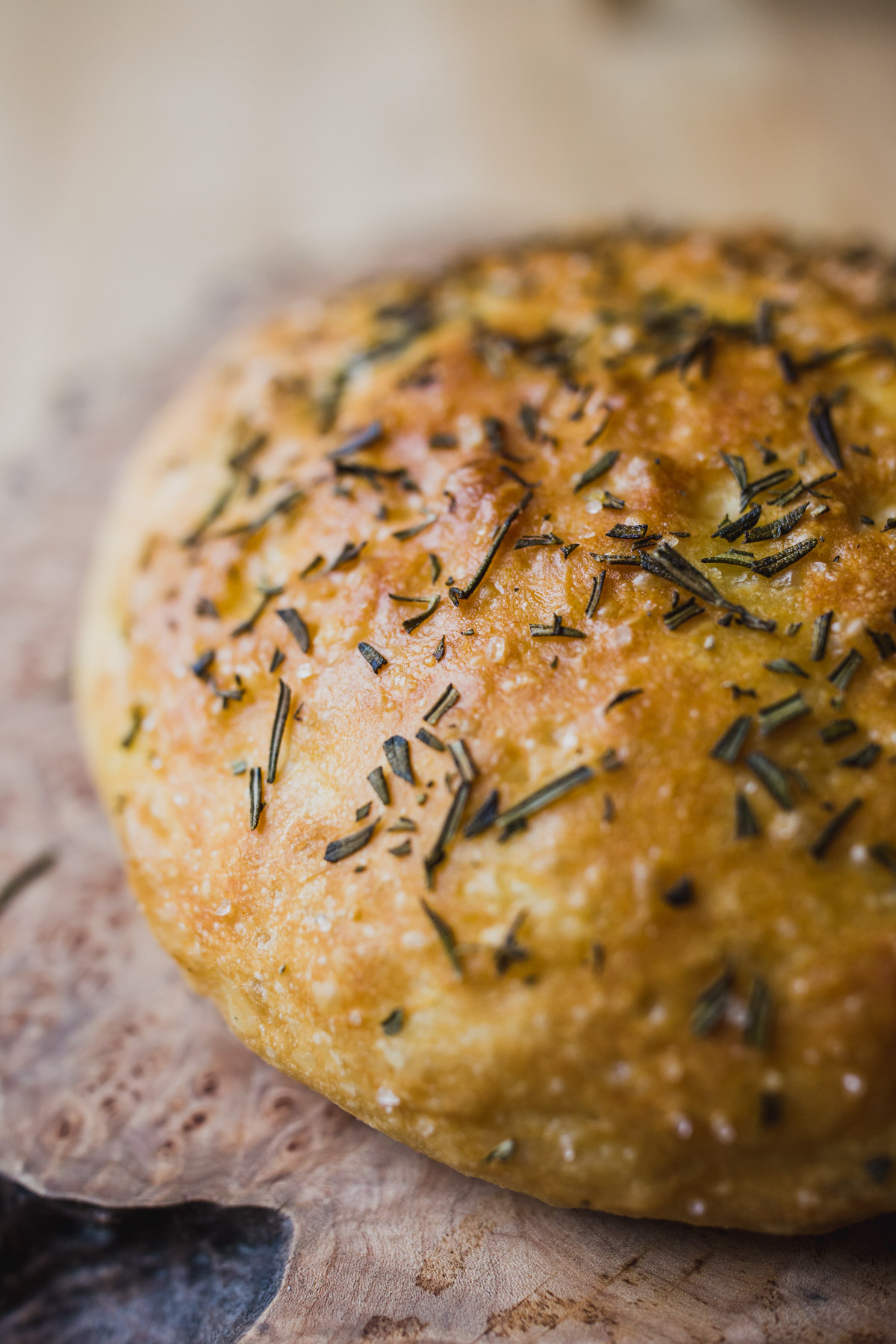
The word “focaccia” is derived from the Latin term “panis focacius,” which refers to bread baked in the ashes of the hearth. This early version of focaccia was a simple unleavened bread cooked on the hearth or in the ashes, and it served as a staple food for many people in the region.
As time has passed, focaccia has changed too. With cultivated yeasts and advancements in baking techniques, focaccia become what we know it as today. Apparently, in medieval times, bakers in Genoa, Italy are the ones credited with refining the recipe by adding extra virgin olive oil to the dough, contributing to the bread’s distinct flavor and moist texture that we all know and love today!
The Ligurian region is often considered the birthplace of focaccia as we know it. They were known for their extensive use of extra virgin olive oil, and this ingredient became a defining element of focaccia, contributing to its characteristic softness and rich flavor.
Focaccia became a staple in Italian cuisine, enjoyed on its own or as a base for various toppings such as herbs, garlic, tomatoes, olives, and more. You even see sandwiches made from it—so delicious!
Today, this versatile bread has not only maintained its popularity in Italy but is one you’ll see all over the world because of how delicious it is! So, let’s talk about what makes focaccia so delicious.
What Is In Focaccia Bread: Key Ingredients for a Fluffy & Flavorful Focaccia
You might be asking yourself, “what is in focaccia bread that makes it so delicious?” For the most part, it’s similar to other breads, but has a few key ingredients that make it pretty spectacular.
Biga: This is a yeast starter, similar to a sourdough starter, but much easier to make. Instead of feeding it for days on end, you need to make it and then use it the next day. A longer fermentation time is what gives it more subtle flavor.
Good Quality Flour: You don’t need to go crazy here, but buying good quality flour will result in a better finished product. My go-to flour brand is King Arthur and you should be able to find it at most grocery stores.
Olive Oil: Focaccia dough is known for its fluffy texture and olive oil flavor. When you can, use the best possible extra virgin olive oil. This olive oil does get baked, so don’t use your fancy finishing oil here, it might be too delicate.
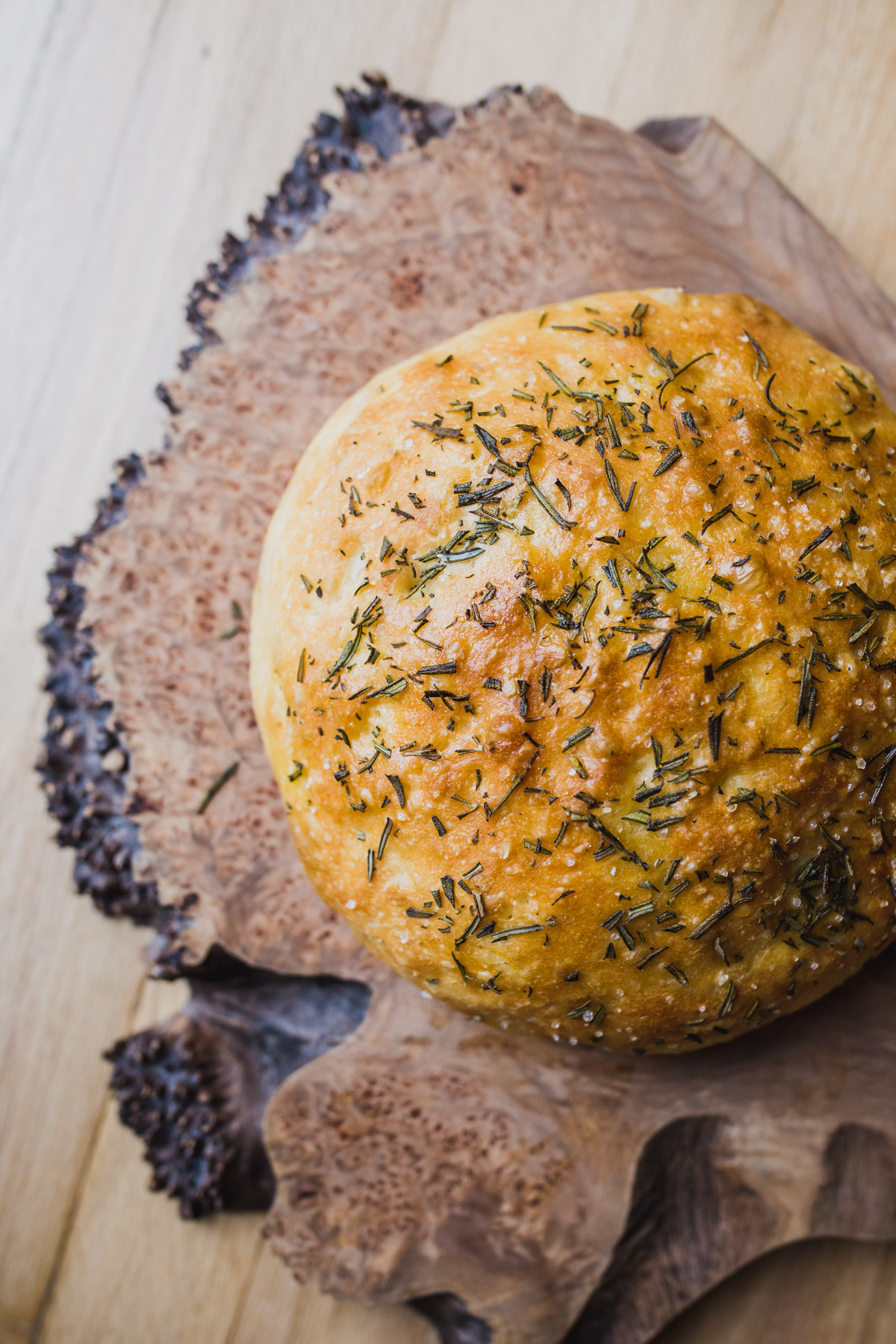
Kosher Salt: Another important element to focaccia is flaky sea salt! I love using a grainy, big coarse salt for finishing on the top. Avoid basic table salt for better flavor and a gorgeous final look of your bread!
Technique: Okay, so this is technically not an actual ingredient, but you’ll find that gently handling the bread dough leads to a lighter, fluffier texture. When you overwork the bread you can end up with a dough with under developed gluten strands. This is why it’s often better to mix by hand than with a stand-mixer because a mixer can quickly over do it.
Temperature: One last “ingredient”—warmer temperatures help the biga grow and your bread rise faster. Find a warm spot in your kitchen for faster results.
How to Make Focaccia Bread—Step-by-Step Instructions
This easy focaccia bread recipe will make you feel confident and comfortable in the kitchen, even if you’re a new baker! This Italian bread is a pretty wet dough and requires a long slow rise, but is absolutely worth it for the most flavorful version of this focaccia recipe.
Basic Focaccia Bread Recipe
Biga:
- 1/2 cup flour (all-purpose flour)
- 1/3 cup warm water (110 degrees)
- 1/4 tsp active dry yeast
Dough:
- 2 1/2 cups all-purpose flour
- 1 1/4 cup warm water (110 degrees)
- 1 tsp dry active yeast
- 2 tsp kosher salt
- 1/4 cup olive oil
- 2 Tbsp fresh rosemary, chopped (or other toppings—more ideas below!)
*recipe adapted from Cook’s Illustrated
Step 1: Make your Biga
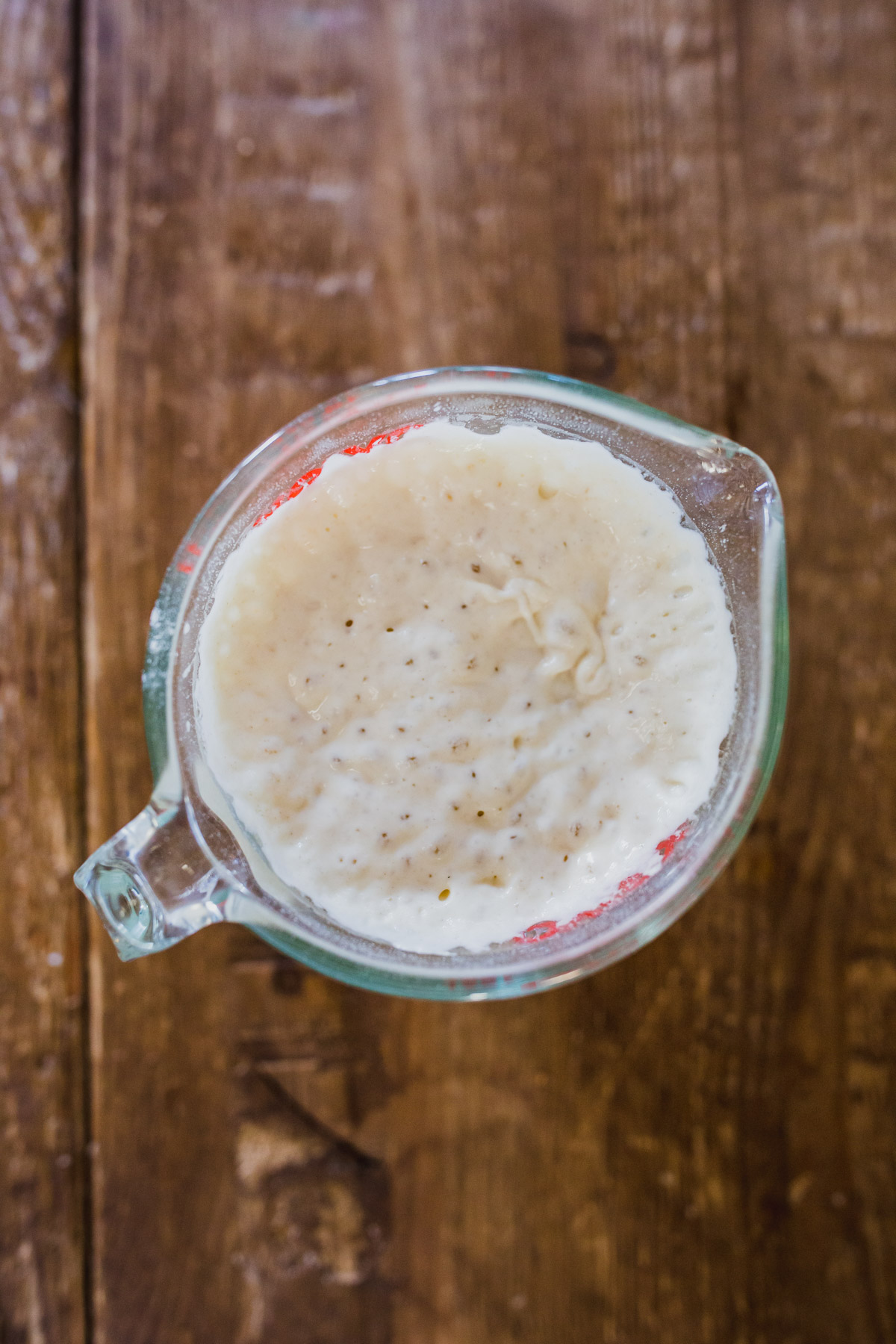
The day before you want to cook your sourdough, you’ll want to make your biga. You can do this on the same day, but I highly recommend starting a day early so you can get the most developed, complex flavors possible!
You’ll mix your ingredients together—flour, water and active dry yeast in a bowl for about a minute until its well-mixed. Cover it in plastic wrap and let it sit overnight on the counter for at least 8 hours, no more than 24 hours.
Step 2: Make the Dough
Mix first 3 dough ingredients—flour, water and active yeast—into the biga and mix until combined and let rest for 15 minutes. You can do this with a fork, your hands, or even a dough hook. If you’re using a dough hook, just make sure to not over knead t.
Add kosher salt to top and combine until fully incorporated. Cover your dough ball in plastic wrap and let rest for another 30 minutes.
Step 3: Folds & Rests
This part is similar to sourdough where you’ll do a series of folds and rests. You can use clean, oiled hands, a rubber spatula, or a dough scraper that’s been sprayed with oil—it’s a sticky dough so something like a dough scraper can really help! You’ll gently fold over the edges into the middle of the dough ball, turning a quarter turn each time, about 6 folds each time. Then cover in plastic wrap and rest for 30 minutes.
Repeat this 2 more times for a total of 3 rounds of folds.
Step 4: Shape Dough
Preheat oven to 500 degrees for 30 minutes before baking. If you have a baking stone or pizza stone, you can put that in the oven before you preheat as well.
Take your dough and divide into 2 equal parts, shaping them into 5-inch round discs. In two 9″ round cake pans or a round baking dish, add about 2 Tbsp of olive oil and 1/2 tsp salt. This is a springy, wet dough so it can be a bit messy to handle so use oiled hands to help keep dough from sticking to you. Place the dough round into the pan and move it around until it’s all covered, flip it over and repeat on the other side. Do this to the second round.
Cover in plastic wrap and let rest for 5 minutes.
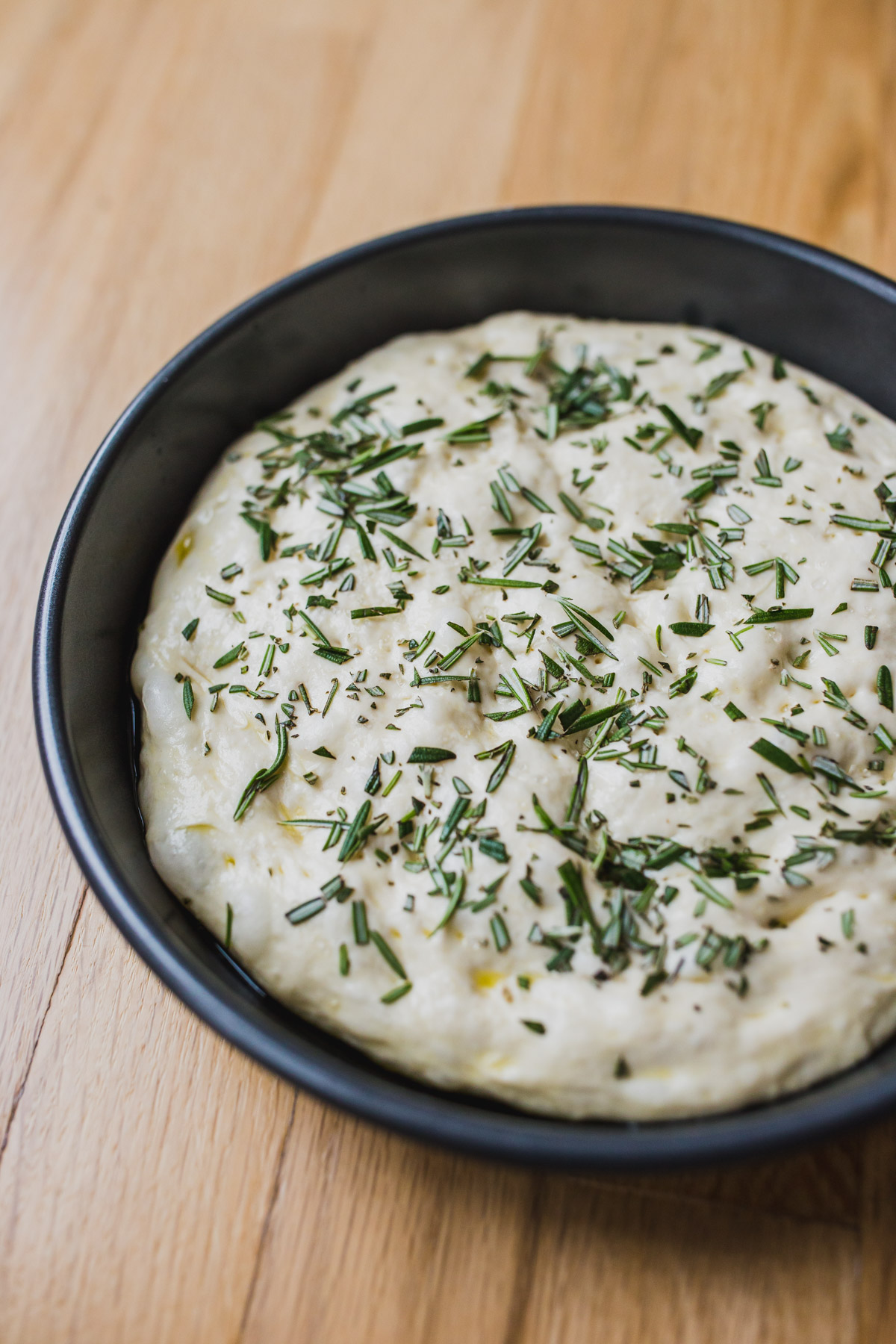
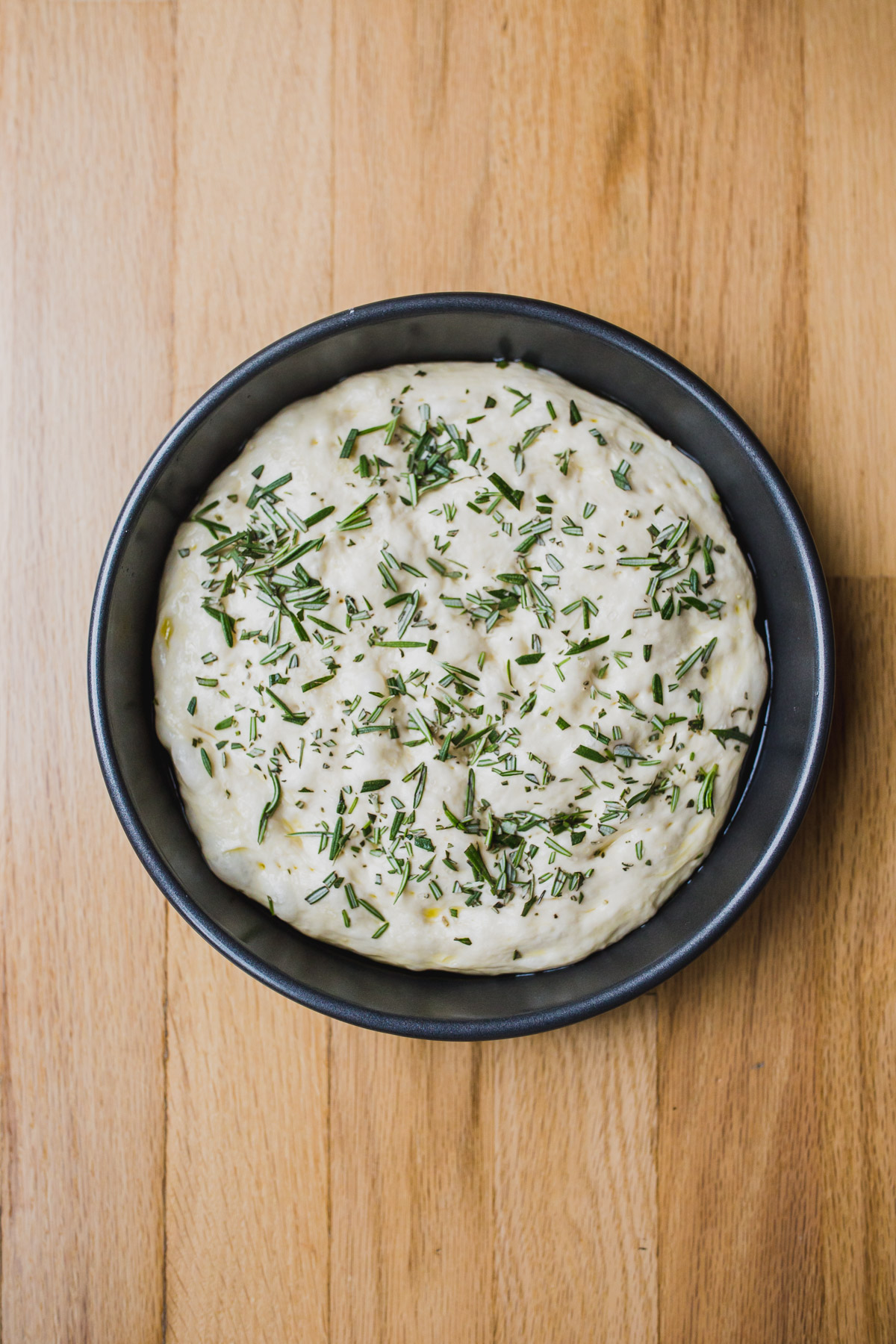
Step 5: Prep for Baking
After 5 minutes, use your clean fingers and gently press them into the dough creating those dimples and pushing the dough to the outside of the pan. You can also use a fork to pop large bubbles. Sprinkle the top with rosemary if you want to make rosemary focaccia like we did, or any other herbs or toppings—look below for more ideas! Let it rest for 10-15 minutes.
Step 6: Bake Focaccia
Pop your baking dishes into the preheated oven on your baking sheet and reduce the temperature to 450 degrees. You’ll bake them until they’re golden brown, about 25-28 minutes. When done, cool in the round baking pans for 5 minutes on cooling racks, then remove and cool for at least 30 minutes on cooling racks. Drizzle any remaining oil from the pans on top.
Slice and enjoy! You can make this as a side or even as a scrumptious bread for paninis!
Tips & Tricks for Perfecting this Homemade Focaccia Bread Recipe
My biggest tip for this bread is to not rush it! Depending on the humidity level and temperature of your climate, you may need to let it rise slightly longer. The final product is absolutely worth the effort it takes to make it! And it’s not really hard, you just need to be patient.
Variations & Toppings
There are endless ways to top this easy focaccia recipe. I love a simple rosemary, but feel free to get creative and add your favorite ingredients to the top! For any fresh herbs that are soft—parsley, basil, I would add those after baking, for everything else I listed below, add before baking!
Tomato & Basil Pesto: Drizzle with basil pesto and then press halved cherry tomatoes into the top before you put it in the oven.
Roasted Garlic and Shallot: I love to roast garlic and can’t wait to try out this combination myself. Roast garlic and thinly slice or mash it and sprinkle on top. Add thinly sliced shallots and gently press into the top alongside the roasted garlic before baking.
Sun-Dried Tomato Focaccia: Add chopped sun-dried tomato and fresh herbs and garlic to the top for a unique flavor.
Fig, Honey & Chevre: This combination makes it more of a meal and is so unique!
Caramelized Onion & Thyme: Caramelize your onions before with herbs and seasonings and layer the cooled mix on your bread just before baking.
Olive & Rosemary: Add these before baking for a yummy, interesting loaf.
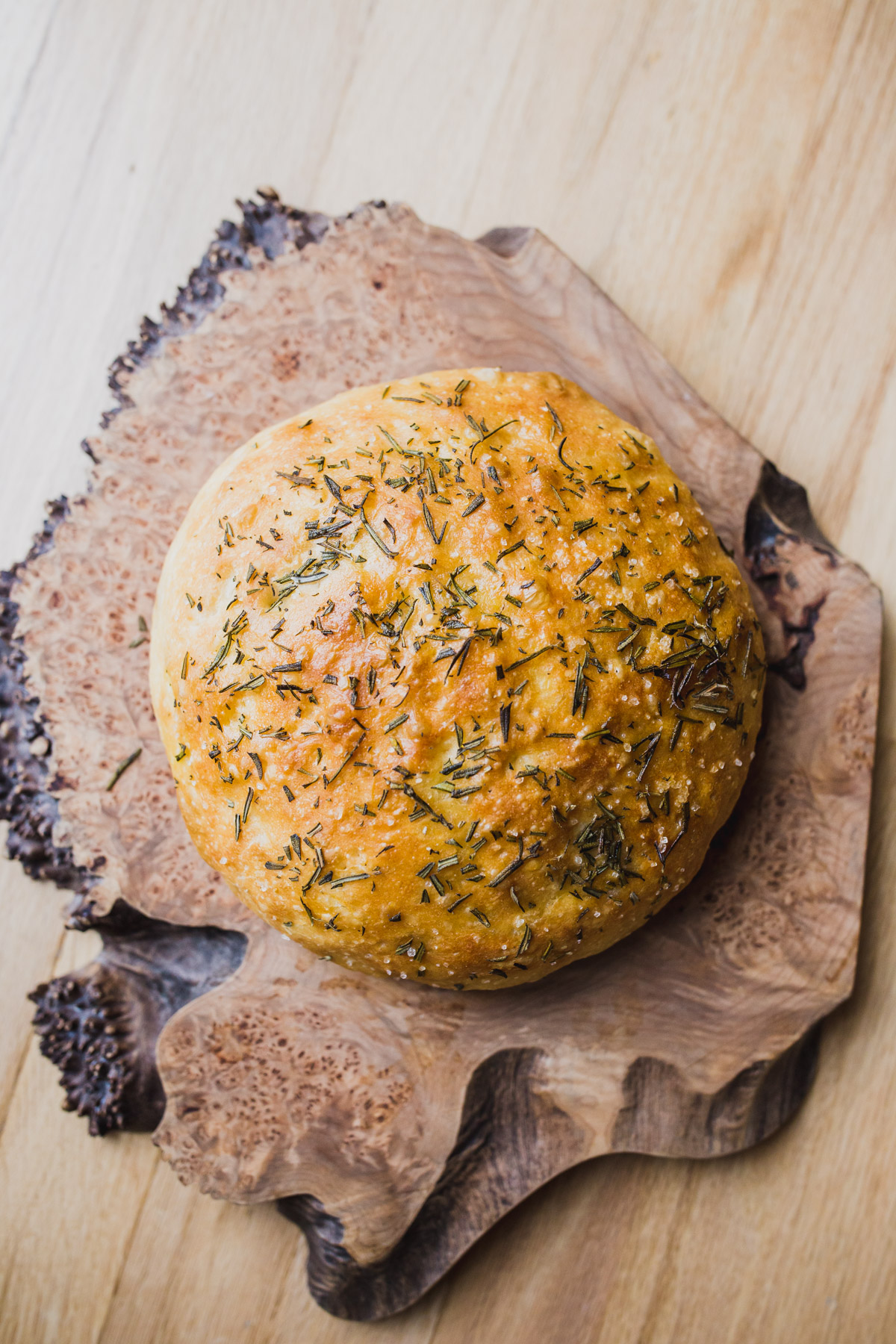
Common Mistakes to Avoid
Rushing the Biga: I know it can be easy to think this step doesn’t matter and if you do skip it, you will likely still end up with a pretty loaf of focaccia, but the flavor that develops while the biga ferments is what makes this so good, so don’t rush it!
Skipping the Preheat: That preheat allows your oven to fully come to temperature before hand and ensures a crisp outside and soft interior.
Too Cold Kitchen: If your kitchen is too cold or you place your dough in a cold area of your kitchen, your dough won’t get a good rise as cold temperatures slow down the fermentation process.
Too Many Toppings: While I love a good topping, adding too many, or too many that have a lot of liquid in them can result in a soggy loaf when we want it to be crisp!
This homemade delicious focaccia bread recipe is simple, straightforward and a total crowd pleaser. Next time you need to bring something to a dinner party or are feeling fancy, grab this recipe and give it a try! It’s got that amazing crisp exterior and soft, fluffy interior that you’ll absolutely love!
BTW, how to make sourdough, and grilled peach, tomato and burrata salad with mint & basil.



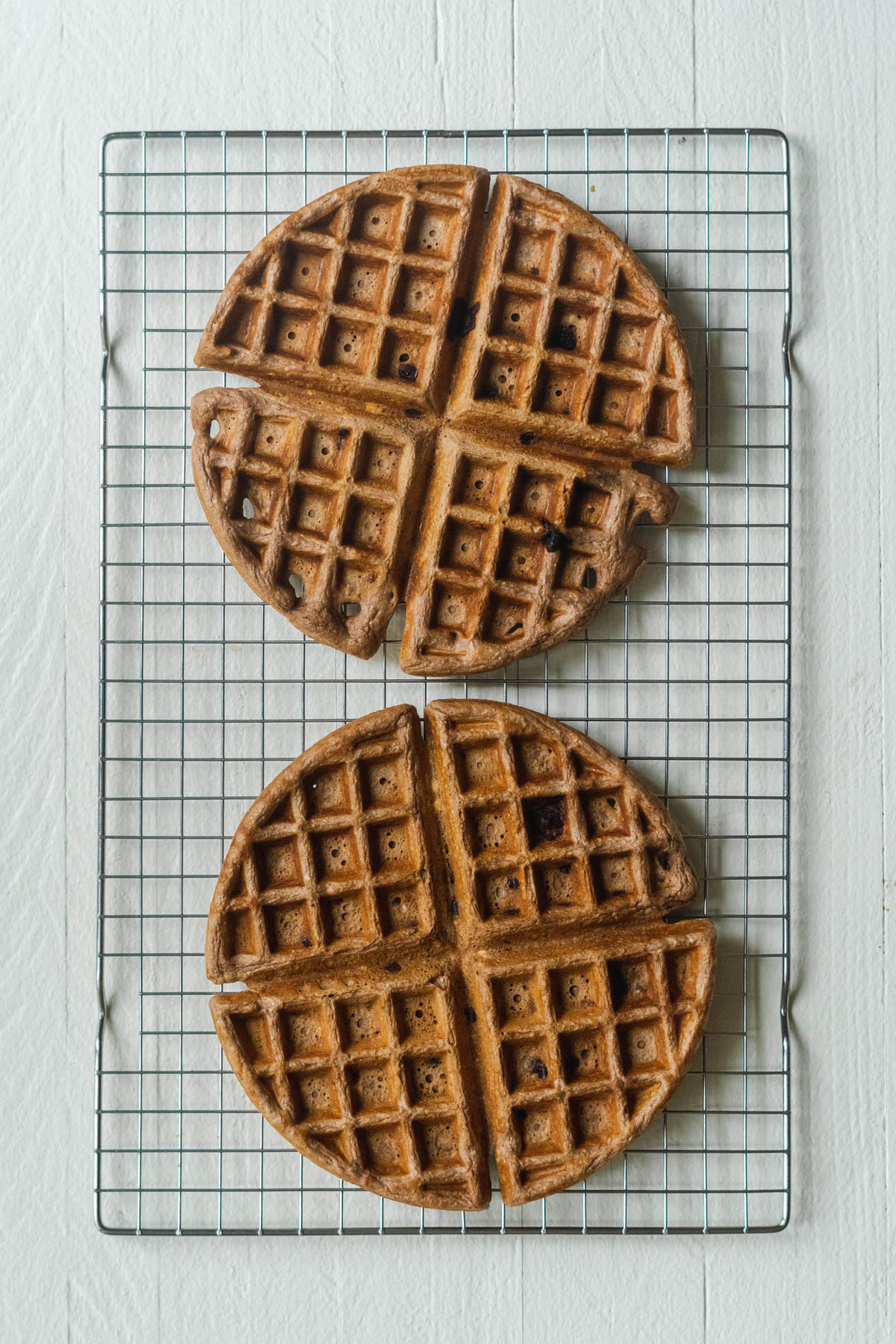


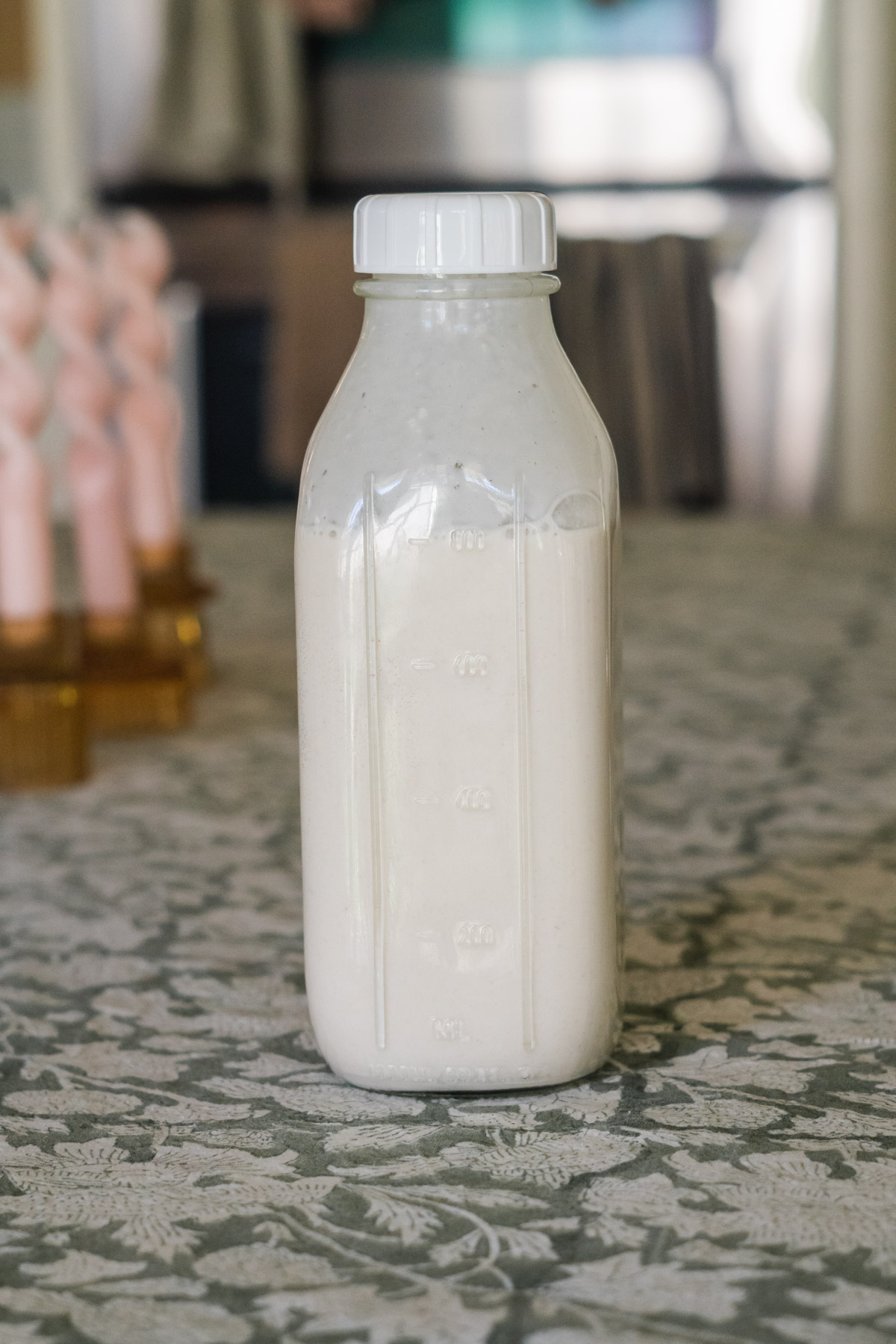

You must be logged in to post a comment.